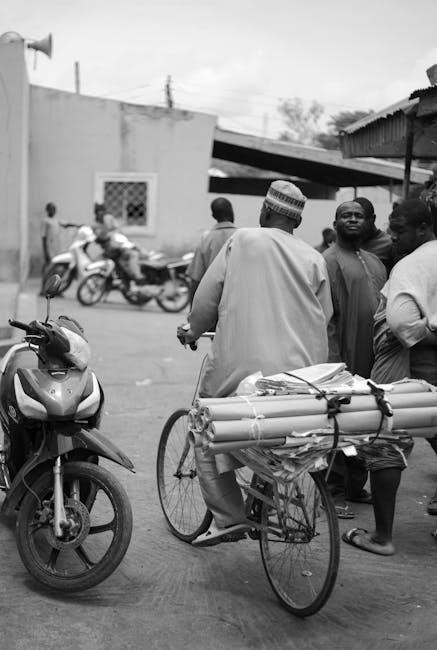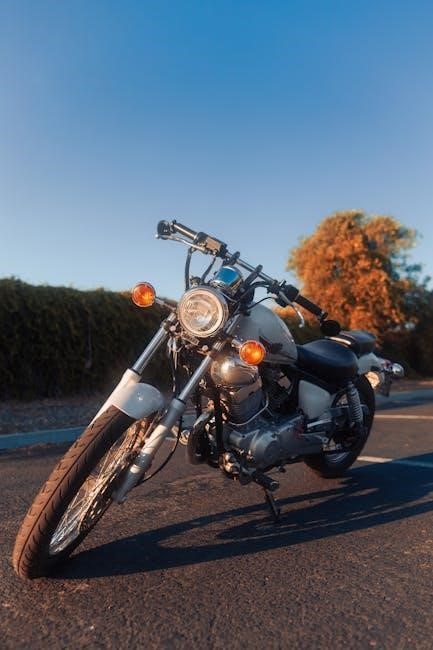Saris bike carriers offer reliable, durable solutions for transporting bicycles, featuring rust-free materials and easy installation. Popular models like the Bones 2 and Bones 3 are known for their versatility and stability, making them a favorite among cyclists. Designed with innovative anti-sway technology, Saris carriers ensure bikes remain secure during transit, while their lightweight construction simplifies handling. Whether for trunk, hitch, or roof mounting, Saris provides options to suit various vehicle types and biking needs, ensuring safe and efficient bike transportation.
1.1 Overview of Saris Bike Carrier Models
Saris offers a range of bike carrier models designed for different needs. The Saris Bones 2 and Bones 3 are popular trunk-mounted carriers known for their durability and anti-sway straps. The Saris Solo is a lightweight, single-bike option, while the Freedom 2-Bike Hitch Rack is ideal for heavier loads. The Stack Rack features two-tier spacing for maximum capacity. Each model is built with rust-free materials and user-friendly designs, ensuring compatibility with various vehicles and bike types, making Saris a versatile choice for cyclists.
1.2 Benefits of Using Saris Bike Carriers
Saris bike carriers are renowned for their durability, rust-free construction, and anti-sway technology, ensuring bikes stay secure during transport. Their lightweight designs make installation and removal hassle-free, while the universal fit adapts to most vehicle types. With models accommodating up to three bikes, Saris offers versatile solutions for cyclists of all levels. The carriers’ sleek, arc-based designs minimize damage risk, and their recyclable materials align with eco-conscious values. These features make Saris a top choice for safe, efficient, and convenient bike transportation.
Pre-Installation Checklist
Ensure vehicle compatibility, gather necessary tools, and consult the Saris Fit Guide. Verify all parts are included and understand installation requirements before starting.
2.1 Understanding Vehicle Compatibility
Verify your vehicle’s compatibility with Saris carriers using the Saris Fit Guide. This guide outlines specific models and vehicle types supported by each carrier. Ensure your vehicle’s make, model, and year are listed for the chosen carrier. Compatibility varies by rack type (trunk, hitch, or roof), so cross-check details to avoid installation issues. Proper fit ensures safety and stability during transport, preventing potential damage to both the carrier and vehicle.
2.2 Essential Tools and Accessories
Ensure you have the necessary tools for installation, such as an Allen wrench, screwdriver, and torque wrench. Additional accessories like anti-sway straps, locking mechanisms, and Saris-specific adapters may be required. Refer to the Saris Fit Guide for vehicle-specific needs. Having the right tools ensures a proper and secure installation, preventing potential damage to your vehicle or carrier. Always use Saris-recommended accessories to maintain compatibility and safety standards.
2.3 Reading the Saris Fit Guide
Consulting the Saris Fit Guide is crucial for ensuring compatibility between your vehicle and bike carrier. This guide provides detailed information on vehicle-specific installation requirements, bike compatibility, and carrier recommendations. It outlines steps to ensure a secure and proper setup, minimizing potential issues. Available on the Saris website or through authorized dealers, the Fit Guide is essential for a safe and reliable installation. Always review it thoroughly before proceeding to avoid common mistakes and ensure optimal performance.
Installation Process
The Saris bike carrier installation involves positioning the rack, adjusting arms and straps, and securing it to your vehicle. Follow specific guides for each model type to ensure proper setup and safety.
3.1 Trunk-Mounted Carriers: Step-by-Step Guide
Installing a trunk-mounted Saris carrier involves positioning it on the vehicle’s trunk or hatch. Begin by placing the carrier evenly and adjusting the arms to fit your bike’s frame. Next, attach the straps to the vehicle’s trunk lid or hatch, ensuring a snug fit. Tighten all straps securely and double-check stability by gently shaking the carrier. Finally, refer to the Saris Fit Guide to confirm compatibility with your vehicle for a safe and proper installation.
3.2 Hitch-Mounted Carriers: Assembly and Attachment
Begin by assembling the hitch-mounted carrier according to the manufacturer’s instructions. Attach the carrier to the vehicle’s hitch receiver, ensuring it is securely locked in place. Tighten all bolts and pins to prevent movement. Use the provided cam buckles to strap the carrier to the hitch, ensuring a snug fit. Finally, insert the hitch pin and secure it with a lock for added safety. The carrier should be stable and firmly attached before loading bikes.
3.3 Roof-Mounted Carriers: Specific Instructions
Roof-mounted carriers require precise installation to ensure stability. Begin by attaching the base rack to your vehicle’s roof using crossbars. Secure the carrier tightly to prevent movement. Load bikes by attaching them to the rack with straps or clamps, ensuring proper alignment. Double-check the Saris Fit Guide for compatibility. Always refer to the manual or online guides for model-specific instructions, such as the Saris Bones 3, to ensure a safe and secure setup for your bikes.
Loading and Securing Bikes
Place bikes on the carrier, ensuring proper alignment. Secure using straps or clamps, following the Saris Fit Guide for compatibility. Double-check all connections for safety.
4.1 Proper Bike Placement on the Carrier
Position bikes on the carrier securely, ensuring they are centered and evenly spaced. Use the Saris Fit Guide to confirm compatibility with your vehicle and bikes. Attach bikes by the frame or wheels, avoiding contact with brake cables or components. Secure bikes firmly using straps or clamps, ensuring they are balanced and stable. Proper placement prevents damage and ensures safe transport. Always double-check alignment and tightness before driving. Improper placement may lead to bike damage or instability during transit.
4.2 Adjusting Straps and Anti-Sway Mechanisms
Adjust straps tightly to secure bikes, ensuring no movement during transit. Engage anti-sway mechanisms to prevent bike-to-bike contact. Pull straps through carriers and tighten firmly, ensuring hooks are securely attached. For optimal stability, align bikes evenly and tighten all connections. Check straps and mechanisms before driving to ensure safety. Proper tension prevents damage and ensures a smooth ride. Always refer to the Saris Fit Guide for specific adjustments based on your bike and carrier model.
4.3 Ensuring Bike Stability
Position bikes evenly on the carrier to distribute weight. Use padding to protect frames and prevent scratching. Secure bikes firmly to avoid movement. Ensure anti-sway mechanisms are engaged to minimize bike-to-bike contact. Tighten all straps and check stability before driving. For added security, double-check the carrier’s attachment to the vehicle. Proper bike placement and tension ensure a stable transport experience, reducing the risk of damage or shifting during transit.

Maintenance and Inspection
Regularly clean the carrier to prevent rust and dirt buildup. Inspect straps, hinges, and bolts for wear and tear. Replace damaged parts promptly to ensure safety and functionality.
5.1 Cleaning the Carrier
Regular cleaning ensures the longevity of your Saris bike carrier. Use mild soap and water to wipe down the frame, arms, and straps. Avoid harsh chemicals or abrasive cleaners, as they may damage the finish or materials. For tougher dirt, soak the parts briefly before scrubbing gently. Rinse thoroughly and allow to air dry. This maintenance step prevents rust and keeps your carrier functioning smoothly for years to come.
5.2 Inspecting for Wear and Tear
Regularly inspect your Saris bike carrier for signs of wear and tear. Check straps for fraying, hinges for rust, and bolts for looseness. Look for any damage to the frame or coating that could compromise durability. If you find worn or damaged parts, replace them immediately to ensure safety and proper function. Refer to the Saris Fit Guide for part replacements or consult their customer support for assistance. Keeping your carrier in good condition prevents accidents and extends its lifespan.
5.3 Storage Recommendations
Store your Saris bike carrier in a dry, protected area to prevent rust and damage. Clean the carrier with mild soap and water, then dry thoroughly before storage. For hitch-mounted models, consider using a protective cover to shield from dust and moisture. Avoid exposure to direct sunlight or extreme temperatures, which can degrade rubber and plastic components. Regularly inspect stored carriers for any signs of wear or damage and address them promptly to maintain optimal condition.
Usage Guidelines
Always adhere to weight limits and ensure bikes are properly secured. Regular checks before driving are essential for safety and to maintain the carrier’s durability over time.
6.1 Weight Limits and Capacity
Always adhere to the specified weight limits for your Saris bike carrier to ensure safe and secure transport. Most models carry 2-3 bikes, with a maximum of 35 lbs per bike. Exceeding these limits can compromise stability and damage the carrier or vehicle. Refer to the Saris Fit Guide for your carrier’s capacity and ensure proper weight distribution. Overloading can lead to unsafe conditions, so verify bike weights before loading. Proper adherence ensures optimal performance and longevity of the carrier.
6.2 Driving Tips with the Carrier Installed
When driving with a Saris bike carrier, ensure a safe experience by maintaining cautious speeds and avoiding sudden maneuvers. Always check mirrors frequently, as the carrier may extend beyond your vehicle’s rear. Be mindful of tight corners and braking distances, as the added weight can affect handling. Regularly inspect the carrier and bikes during long trips to ensure everything remains secure. Avoid high speeds and use extra caution in windy or rainy conditions to maintain control and stability while towing bikes.
6.3 Avoiding Common Mistakes
Avoid common mistakes by ensuring proper installation, adhering to weight limits, and securing bikes tightly. Never overload the carrier, as this can compromise stability and safety. Always double-check strap tightness and ensure the carrier is correctly fitted to your vehicle. Avoid using damaged straps or components, as they may fail during transit. Regularly inspect the carrier for wear and tear, and follow the Saris Fit Guide for compatibility. Proper preparation prevents mishaps and ensures safe, stress-free bike transportation.

Troubleshooting Common Issues
Common issues include loose straps, stability problems, or compatibility concerns. Address these by tightening components, adjusting the fit, and ensuring proper installation according to the Saris Fit Guide.
7.1 Addressing Loose Straps or Arms
If straps or arms on your Saris bike carrier are loose, ensure all components are securely tightened. Inspect straps for wear and tear, replacing them if damaged. For arms, check the connection points and tighten any bolts or screws. Regularly maintaining these parts ensures stability and prevents shifting during transit. Always refer to the Saris Fit Guide for specific tightening instructions and torque specifications to guarantee a secure attachment and safe transportation of your bikes.
7.2 Fixing Stability Problems
To address stability issues with your Saris bike carrier, start by ensuring all anti-sway mechanisms are properly engaged. Check that bikes are evenly distributed and securely fastened. If the carrier wobbles, tighten all connection points and straps. Recheck bike placement to ensure proper balance and alignment. If instability persists, consult the Saris Fit Guide for vehicle-specific adjustments or consider additional support accessories to enhance stability during transit.

7.3 Solving Compatibility Issues
If your Saris bike carrier doesn’t fit your vehicle, consult the Saris Fit Guide to confirm compatibility. Ensure the carrier is properly adjusted and matched to your vehicle’s make and model. If issues persist, check for loose or misaligned straps and reposition the carrier. If the problem remains unresolved, consider upgrading to a different Saris model better suited for your vehicle. Contact Saris customer support for personalized assistance or to explore alternative solutions tailored to your needs.

Comparing Saris Bike Carrier Models
Saris offers various bike carrier models, each designed for specific needs. The Bones 2 and Bones 3 are popular trunk-mounted options, while the Freedom 2-Bike Hitch Rack excels for hitch installations. The Solo model is ideal for single-bike transport, offering lightweight convenience. Each model varies in capacity, compatibility, and features, ensuring cyclists can choose the perfect fit for their vehicle and biking lifestyle.
8.1 Saris Bones 2 vs. Bones 3
The Saris Bones 2 and Bones 3 are popular trunk-mounted carriers, with key differences in bike capacity. The Bones 2 carries 2 bikes, while the Bones 3 accommodates 3; Both feature rust-free construction, anti-sway straps, and an arc-based design for stability. The Bones 3 offers slightly more versatility for larger families or groups. Both models are compatible with most vehicles and made in the USA, ensuring durability. Choosing between them depends on your biking needs and vehicle size.
8.2 Saris Solo vs. Freedom 2-Bike Hitch Rack
The Saris Solo and Freedom 2-Bike Hitch Rack cater to different needs. The Solo is a lightweight, compact option ideal for single-bike transport, while the Freedom 2-Bike offers versatility for two bikes. Both feature easy hitch installation and bike loading. The Freedom model includes adjustable arms for better bike fit and anti-sway technology, making it suitable for longer trips. Choose the Solo for simplicity and the Freedom for added capacity and stability, depending on your biking lifestyle and vehicle setup.
8.3 Choosing the Right Model for Your Needs
Selecting the right Saris bike carrier depends on your biking habits, vehicle type, and budget. Consider the number of bikes you’ll transport, as models like the Solo cater to single bikes, while others accommodate multiple. Check vehicle compatibility using the Saris Fit Guide and hitch size requirements. Prioritize features like anti-sway technology or ease of installation based on your lifestyle. Assessing these factors ensures you find a model that meets your needs for durability, convenience, and performance, enhancing your biking adventures.
Accessories and Upgrades

Saris offers accessories like the Tailgate Pad and customizable Stack Rack to enhance functionality. Upgrade your carrier with G-hooks for quicker loading and improved versatility, ensuring optimal performance.
9.1 Recommended Saris Accessories

Enhance your Saris bike carrier with recommended accessories like the Tailgate Pad, available in 5- and 6-bike options, featuring G-hooks for quick loading. The Stack Rack offers customizable, two-tier spacing for added capacity and density. These accessories improve functionality and versatility, ensuring secure and efficient bike transport. Saris also provides add-ons like anti-sway straps and hitch adapters, tailored to specific carrier models, ensuring compatibility and optimal performance for your biking adventures.
9.2 Upgrading Your Carrier
Upgrading your Saris carrier can enhance performance and versatility. Consider adding the Saris MHS (Modular Hitch System) for improved stability and compatibility with various hitch sizes. The Stack Rack offers a customizable, two-tier design, increasing bike capacity while maintaining durability. Anti-sway technology upgrades ensure bikes stay secure during transit. These upgrades integrate seamlessly with existing Saris models, providing a tailored solution for your biking needs. Always follow Saris guidelines for compatibility and installation to ensure safety and optimal performance.
9.3 Customizing Your Setup

Customizing your Saris carrier allows you to tailor it to your specific biking needs. Consider adding the Saris Tailgate Pad, available in 5- and 6-bike options, which replaces standard straps with G-hooks for faster, more versatile loading. The Stack Rack offers a customizable, two-tier design, perfect for maximizing bike capacity while maintaining durability. Additional accessories like anti-sway straps or specialized bike mounts can further enhance your setup, ensuring compatibility with various bike types and sizes. Always follow Saris Fit Guide recommendations to ensure compatibility and safety.

Safety Tips and Precautions
Always ensure proper installation, check attachments before each use, and verify vehicle compatibility to avoid accidents. Regular inspections and adherence to weight limits are crucial for safe transport.
10.1 Pre-Drive Checks
Before driving, inspect all straps, arms, and hinges for tightness and damage. Ensure bikes are properly secured with anti-sway mechanisms engaged. Verify that the carrier is firmly attached to the vehicle, checking for any loose bolts or clips. Always confirm that the weight limit is not exceeded and that all bikes are balanced evenly. Perform a quick walk-around to ensure no obstructions or hazards are present. This routine helps prevent issues during transit and ensures a safe journey for both you and your bikes.
10.2 Ensuring Proper Carrier Attachment
Always follow the Saris Fit Guide for your vehicle to ensure correct carrier installation. Position the carrier firmly on the trunk, hitch, or roof, aligning it with the vehicle’s surface. Tighten all straps and bolts evenly, ensuring no movement. Check that the carrier is level and securely fastened to prevent shifting during transit. Double-check that all hooks and straps are properly engaged, and verify stability by gently rocking the carrier. Consult the manual for specific attachment requirements to guarantee a safe and secure fit.
10.3 Road Safety with a Bike Carrier
Ensuring road safety with a Saris bike carrier involves proper loading and securing of bikes to prevent movement during transit. Always follow weight guidelines and use anti-sway mechanisms to maintain stability. Be aware of increased vehicle length and width when bikes are loaded, especially in tight spaces. Drive at a safe speed, avoid sharp turns, and maintain a safe distance from other vehicles. Regular pre-drive checks and adherence to traffic laws are crucial for a secure and incident-free journey with your Saris bike carrier.

Frequently Asked Questions (FAQs)
Common questions include vehicle compatibility, weight limits, and maintenance tips. Users often inquire about proper bike loading and troubleshooting common issues like loose straps or stability problems.
11.1 Can I Use My Saris Carrier on Multiple Vehicles?
Compatibility depends on your vehicle and carrier model. Always consult the Saris Fit Guide for specific vehicle recommendations. Some carriers are versatile, while others are designed for specific vehicle types. Ensure proper fit and attachment for safety and stability across different vehicles. Adjustments may be needed for each vehicle to maintain secure bike transport. Refer to the Saris Fit Guide for detailed instructions and compatibility checks before using your carrier on multiple vehicles.
11.2 How Do I Prevent Bike Damage?
To prevent bike damage, ensure proper placement on the carrier, avoiding contact between bikes. Use padding or frame protectors for fragile parts. Secure bikes tightly with straps, but avoid over-tightening, which can damage frames or components. Regularly inspect the carrier and bikes for wear. Clean the carrier to prevent rust or debris transfer. Follow Saris’ specific guidelines for bike placement and strap adjustment to minimize movement during transit and protect your bike from scratches or dents.
11.3 What If My Carrier Doesn’t Fit My Vehicle?
If your Saris carrier doesn’t fit your vehicle, consult the Saris Fit Guide to verify compatibility. Ensure the carrier is properly adjusted and aligned with your vehicle’s trunk or hitch. If issues persist, contact Saris customer support for assistance or visit an authorized dealer for a proper fit. Proper installation is critical for safety and functionality, so double-check all adjustments before use to ensure a secure and stable connection.
With proper installation, maintenance, and adherence to guidelines, Saris bike carriers provide reliable and efficient bike transportation solutions. Their durable designs, anti-sway features, and vehicle compatibility ensure safe and secure bike travel. Always follow the Saris Fit Guide and user manuals for optimal performance. By investing in a Saris carrier, cyclists can enjoy hassle-free adventures, knowing their bikes are protected and stable during transit. Refer back to this guide for future reference to maximize your Saris bike carrier’s functionality and longevity.
